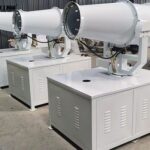Water mist cannon is a piece of equipment designed to spray fine water droplets into the air to capture and suppress dust particles. These devices create a mist of microfine water droplets that effectively bind with dust particles, causing them to become heavier and fall to the ground. This results in significantly reduced airborne dust and improved air quality. Mist cannons are powered by motors and pumps, which allow them to generate a high-pressure water stream. The mist is typically dispersed through a rotating nozzle or a fan, allowing for widespread coverage across large areas. The main advantage of water cannons over traditional dust suppression methods, such as water sprinklers or manual spraying, is their ability to produce fine mist particles that can capture even the smallest dust particles.
Applications Of Water Mist Cannon
The versatility of fog cannon machine makes them indispensable across multiple sectors
1 Construction and Demolition Sites
Construction activities generate substantial dust from excavation material handling and vehicle movement Water fog cannons are deployed to suppress particulate matter ensuring compliance with air quality standards and protecting workers’ health
2 Mining and Quarrying
Mining operations often produce silica dust and other hazardous particles. Prolonged exposure to these materials can lead to respiratory diseases. Water mist cannon mitigates risks by maintaining cleaner air in openpit mines and processing areas
3 Agricultural Dust Management
During harvesting, plowing, or livestock farming, dust and allergens become airborne. Water mist systems reduce these particles, improving conditions for workers and nearby communities
4 Urban Air Quality Control
In cities water mist cannons are used to tackle pollution hotspots such as traffic junctions or industrial zones They also serve as temporary solutions during extreme smog events
Benefits of Using Water Fog Cannons
Compared to traditional methods, the water mist cannon offers compelling advantages:
Superior Efficiency: The atomization process creates a massive surface area from a relatively small amount of water, making it highly effective at capturing dust or facilitating evaporation.
Improved Air Quality: By effectively suppressing airborne dust particulates, they create healthier working environments and help sites meet environmental air quality standards.
Enhanced Safety: Reduced dust improves visibility on site, lowering the risk of accidents. Controlling dust also reduces the risk of respiratory diseases. Effective cooling reduces heat stress risks.
Operational Efficiency: Automated features like oscillation and remote control reduce labor requirements compared to manual spraying. Wide area coverage means fewer units are needed.


